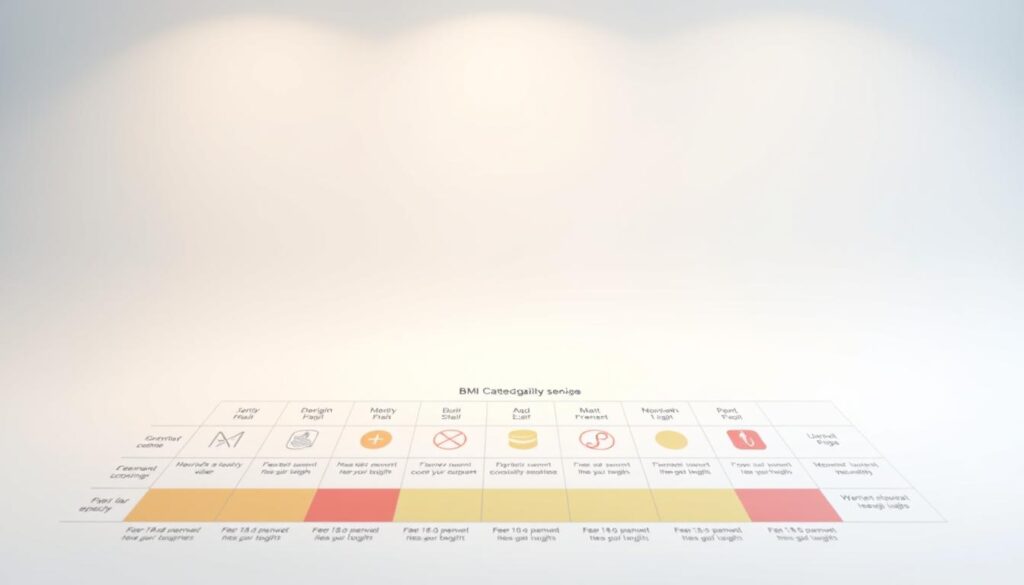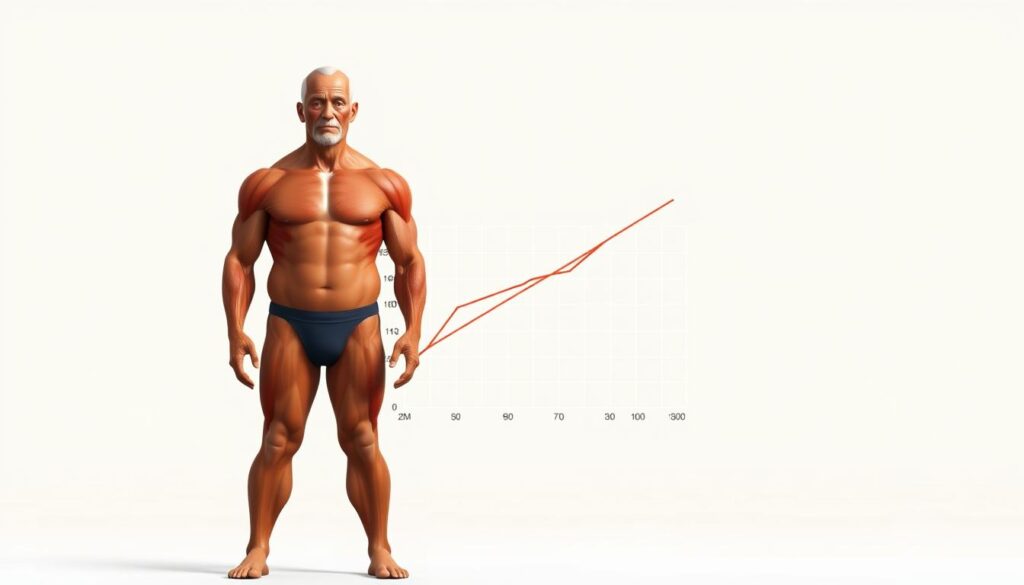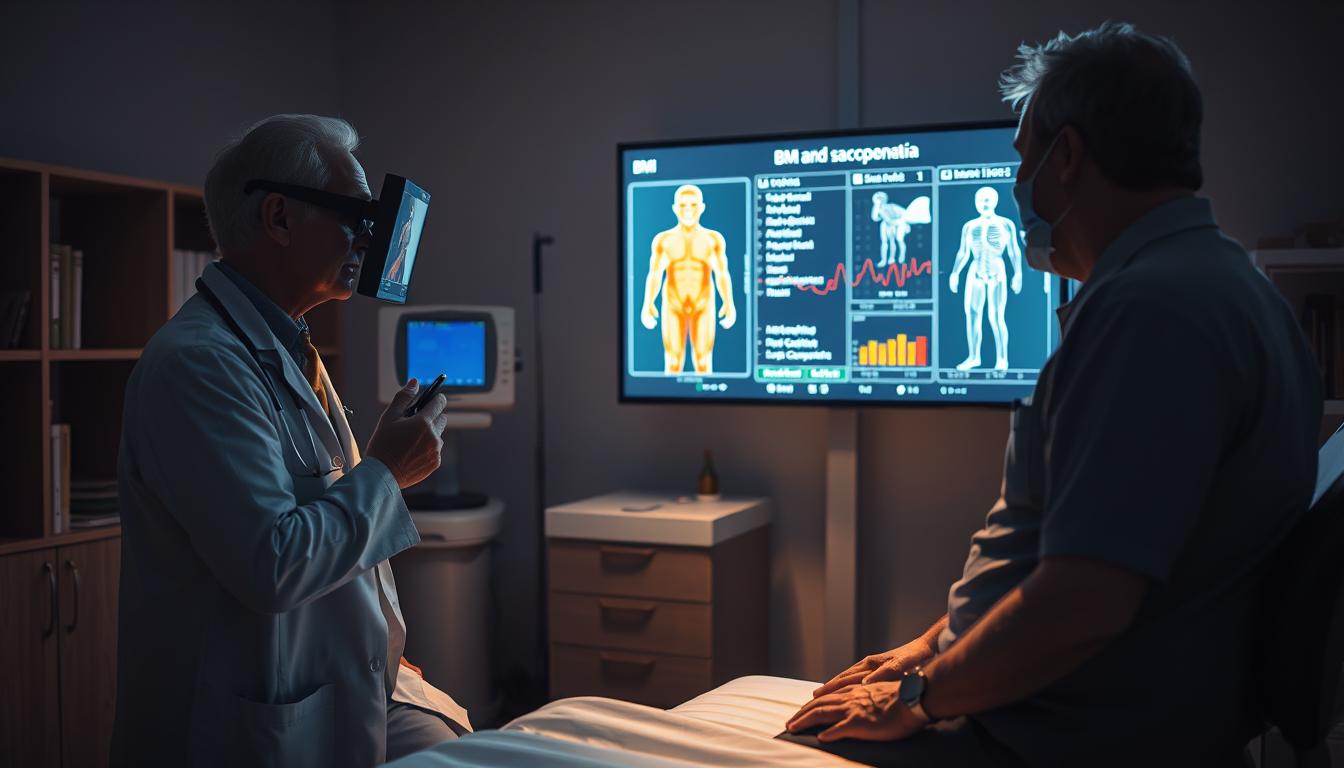As we age, our bodies change a lot. Are we doing enough to keep our muscle mass and healthy weight? It’s key to understand how Body Mass Index (BMI) and sarcopenia relate to healthy aging.
Using a BMI calculator shows if our weight is healthy for our height. But, it doesn’t show the whole picture, mainly for older adults whose body composition changes.
Studies have found a strong link between BMI and sarcopenia. Sarcopenia is losing muscle mass and strength. By looking into this connection, we can find ways to support senior health and wellness.
Key Takeaways
- Understanding BMI and its limitations is crucial for assessing health risks in seniors.
- Sarcopenia is a significant health concern for older adults, affecting their quality of life.
- The relationship between BMI and sarcopenia can inform strategies for healthy aging.
- Maintaining muscle mass and a healthy weight is vital for overall health.
- Using health tools, like BMI calculators, can help monitor and manage health.
Understanding BMI and Its Importance for Seniors
As we get older, knowing our body mass index (BMI) is key to staying healthy. BMI is a simple way to check if we’re at a healthy weight. It helps spot risks linked to being too thin, too heavy, or obese.
What is BMI?
BMI is a measure of weight to height. It shows if we’re at a healthy weight or not. For older adults, knowing BMI is vital. It helps understand health risks and how long we might live.
How is BMI Calculated?
To find BMI, divide your weight in kilograms by your height in meters squared. This gives a basic idea of if your weight is healthy for your height.
Formula: BMI = weight (kg) / height (m)2
BMI Categories Explained
The World Health Organization (WHO) has set BMI categories:
- Underweight: BMI
- Normal weight: BMI = 18.5-24.9
- Overweight: BMI = 25-29.9
- Obese: BMI ≥ 30
| BMI Category | BMI Range | Health Risks |
|---|---|---|
| Underweight | Osteoporosis, weakened immune function | |
| Normal weight | 18.5-24.9 | Lower risk of chronic diseases |
| Overweight | 25-29.9 | Increased risk of cardiovascular disease, diabetes |
| Obese | ≥ 30 | High risk of chronic diseases, certain cancers |

Seniors can better understand their health risks by knowing BMI and its categories. But, it’s important to remember BMI has its limits. It doesn’t directly show body composition or the difference between muscle and fat.
What is Sarcopenia?
As we age, our bodies change in many ways. One big change is losing muscle mass, known as sarcopenia. This is a big health issue for older adults, affecting their life quality and independence.
Sarcopenia means losing muscle strength and mass over time. It gets worse with less physical activity and bad nutrition.

Definition and Diagnosis of Sarcopenia
Sarcopenia is when you lose muscle mass, strength, and function. Doctors check muscle strength, mass, and how well you move. They use dual-energy X-ray absorptiometry (DXA) and bioelectrical impedance analysis (BIA) to measure muscle.
They also test handgrip strength and how fast you walk. These tests help doctors find sarcopenia and plan treatment.
Causes of Sarcopenia in Seniors
Many things can lead to sarcopenia in seniors, like aging, physical inactivity, poor nutrition, and some medical conditions. Aging is a main reason, causing natural muscle loss.
Not moving much makes it worse. Not eating enough protein also speeds up muscle loss. Knowing these causes helps find ways to stop and treat sarcopenia.
The Link Between BMI and Sarcopenia
The connection between BMI and sarcopenia is key, mainly in elderly nutrition. It shows that being too thin or too heavy can raise the risk of sarcopenia.
Studies show that a healthy BMI is vital to avoid sarcopenia. But, it’s not just about being in the right weight range. Being too light or too heavy can also increase the risk.

How BMI Affects Muscle Mass
BMI impacts muscle mass in different ways. Being underweight might mean not enough muscle, which is a big part of sarcopenia. Being overweight, with too much body fat, can also lead to muscle loss and weaker muscles.
It’s important to know how BMI affects muscle to create good plans. For example, older adults who are too thin might need protein supplements to grow muscle. Those who are overweight might need to lose fat while keeping or growing muscle.
The Role of Nutrition
Nutrition is key in fighting and managing sarcopenia. Eating enough protein is crucial for muscle repair and growth. Older adults need enough protein and other nutrients to keep their muscles strong.
In the fight against frailty in older adults, good nutrition is a big help. This means enough protein and a diet full of vitamins and minerals.
By understanding how BMI and sarcopenia are linked, we can make better plans to help older adults live better lives.
Recognizing the Symptoms of Sarcopenia
As we get older, it’s important to spot the signs of sarcopenia to keep our senior health and wellness in check. Sarcopenia is a muscle loss condition that makes simple tasks hard. Catching it early is crucial for managing it well.
Physical Signs to Watch For
Spotting physical signs is the first step in recognizing sarcopenia. These signs include reduced muscle strength and endurance, affecting our daily tasks. We might find it harder to do things we used to love.
Some common physical signs to watch for include:
- Loss of muscle mass
- Decreased strength
- Reduced endurance
- Difficulty with balance and coordination
Diagnostic Tests and Assessments
Diagnostic tests and assessments are key in identifying sarcopenia. Healthcare experts use tests like handgrip strength tests and gait speed assessments. These help figure out how much muscle loss we have and its effect on our geriatric health and fitness.
Some common diagnostic tests include:
- Handgrip strength test
- Gait speed assessment
- Muscle mass measurement
The Impact of Sarcopenia on Senior Health
Sarcopenia, or muscle loss, has big health effects on seniors. It makes older adults more likely to fall, break bones, and die. Knowing these effects is key to fighting muscle loss in older age.
Functional Limitations and Independence
Sarcopenia causes functional limitations, making daily tasks hard for seniors. Simple actions like walking or getting up from a chair become tough. This affects their ability to live independently.
As muscle loss gets worse, it harms not just physical skills but also overall health. This leads to a lower quality of life.
Risk Factors for Falls and Injuries
Sarcopenia raises the risk of falls and injuries in seniors. With less muscle, older adults are more likely to break bones or get hurt after a fall.
Here’s some data to show how sarcopenia affects seniors:
| Health Impact | Description | Consequence |
|---|---|---|
| Functional Limitations | Difficulty in performing daily activities | Loss of Independence |
| Increased Risk of Falls | Reduced muscle mass and strength | Fractures and Injuries |
| Mortality Risk | Complications from falls and reduced physical function | Increased Mortality Rates |
It’s important to understand how sarcopenia affects seniors’ health. By tackling muscle loss and frailty, we can enhance the lives of older adults.
Strategies for Prevention and Management
As we get older, keeping our muscles strong is key to staying healthy. There are good ways to do this. We need to eat right and exercise to fight off muscle loss.
Nutritional Approaches to Combat Sarcopenia
Eating well is very important for muscle health in older adults. We need to make sure we get enough protein to help our muscles grow. A diet full of vitamins and minerals, like vitamin D and calcium, also helps our muscles and bones.
Eating foods that are full of nutrients, like lean proteins, whole grains, fruits, and veggies, helps our muscles. Drinking plenty of water is also important for keeping our muscles working well.
Importance of Resistance Training
Resistance training is a must for keeping muscles strong. It helps us build and keep muscle, which makes us stronger and less likely to fall or get hurt.
Doing exercises like weightlifting or bodyweight exercises regularly can really help geriatric health and fitness. Start slow and get stronger over time to avoid injuries and keep exercising for a long time.
By eating well and doing resistance training, we can fight off muscle loss. This helps us stay independent and live a good life as we age.
Resources and Tools for Seniors and Caregivers
Understanding senior health and wellness is key, with a focus on BMI and sarcopenia. It’s important to have the right resources. Many organizations and support groups offer valuable help and information.
Organizations and Support Groups
The National Institute on Aging provides insights into aging and health, including sarcopenia. Support groups, both online and in-person, offer a sense of community. They help seniors and caregivers understand and cope with these issues.
Educational Materials and Infographics
Infographics can make complex information about BMI and sarcopenia easier to understand. They show how to keep a healthy BMI and prevent sarcopenia. Online resources highlight the importance of resistance training and proper nutrition.
Studies show that resistance exercise training can improve muscle mass and strength in seniors with sarcopenia. This is discussed on the National Center for Biotechnology Information website.
Further Reading and References
For deeper information, many studies and guidelines are available. Groups like the Asian Working Group for Sarcopenia (AWGS) and the European Working Group on Sarcopenia in Older People (EWGSOP) offer detailed insights. These resources support overall senior health and wellness.

